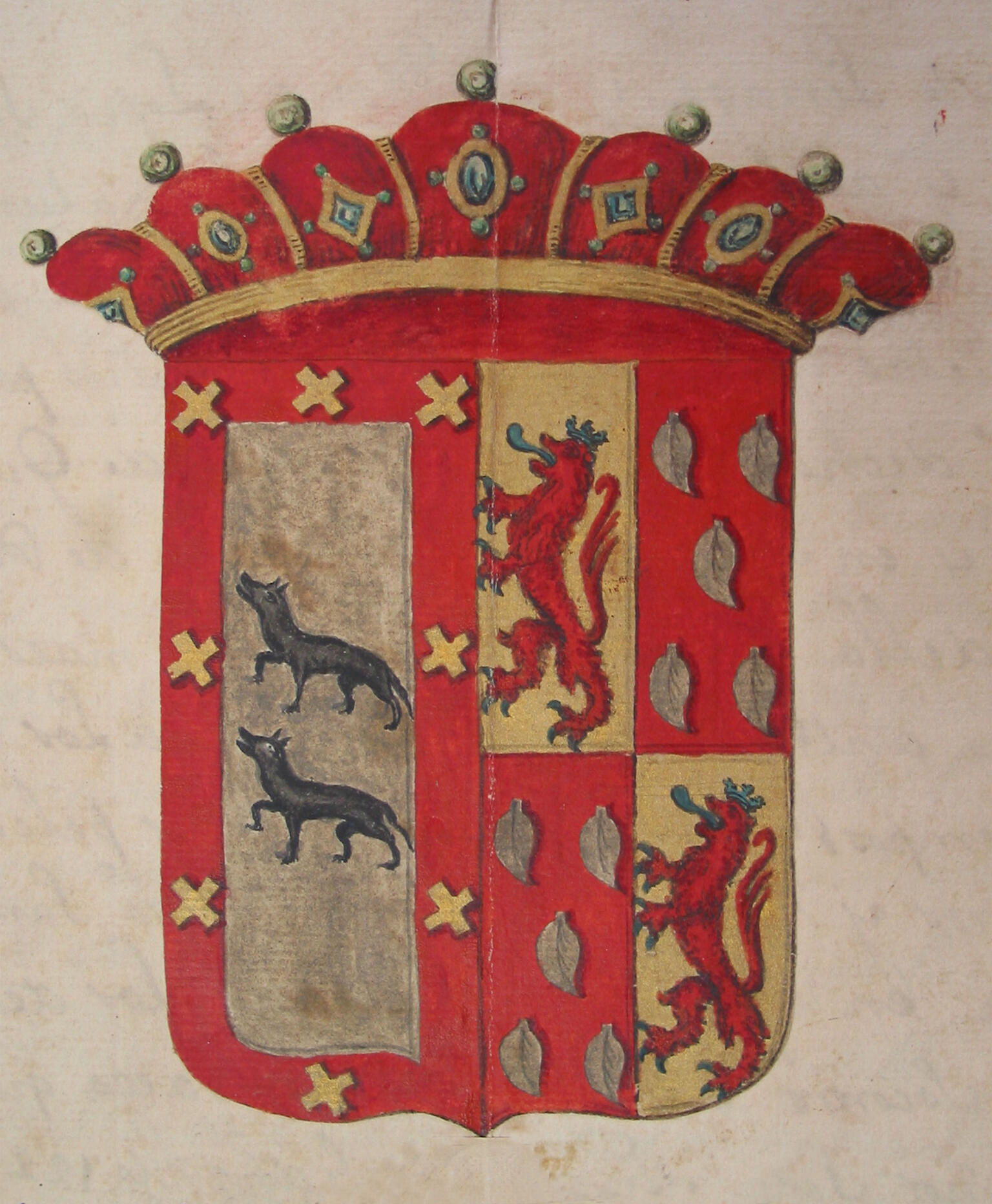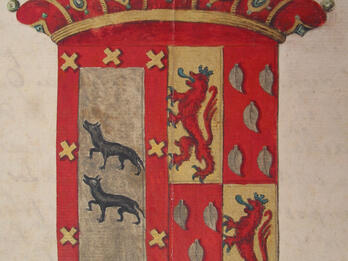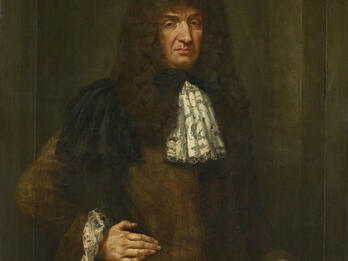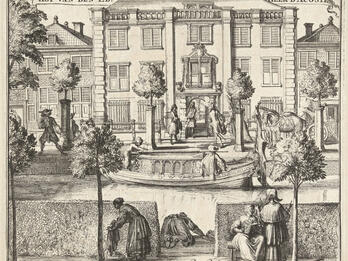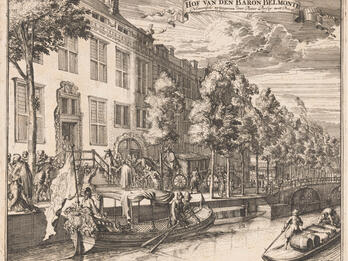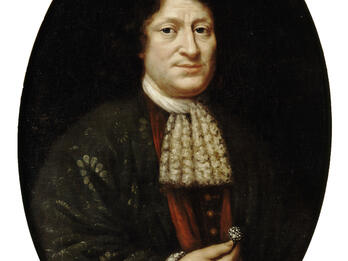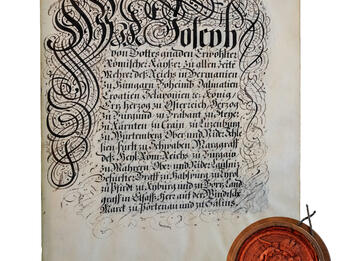Explicasion de las armas de Lopes y Suaço (Explanation of the Arms of Lopez and Suasso)
I, Don Pedro Alberto de Launay Cauo, gentleman of the Royal House of King Charles II, in charge of the heraldry and chronicles of his Spanish realms, of provincial arms, and, earlier, of his estates in Flanders and Brabant, etc.
Do certify and give full faith and credit to all that this letter and certification of lineage comprise, as in the books of heraldry and genealogy charts in my possession that blazon the arms of the noble houses of said realms, including the lineages and arms of Lopez and Suaço, described as follows:
Those of the lineage and surname of Lopez are very fine, very ancient descendants of inhabitants of the Orozco Valley in the lordship of Biscay. Their noble line stretches far back in time and spreads throughout the lordship of Biscay and the provinces of Gipuzkoa and Álava, as well as other areas of Spain, Portugal, and beyond. Wherever they resided, they demonstrated their nobility and ancient lineage, serving their kings as courageous soldiers fighting against the Moors and enemy heretics of our holy Catholic faith. Most importantly, they rescued the palace of Baeza. In 1227 on Saint Andrew’s day, Don Lope Días de Haro, the sixteenth Count and Lord of Biscay, on the orders of King Ferdinand the Saint, went with five hundred noblemen from the court to effect the rescue. Not only did they oblige the Moors to lift the siege, but they forced them to leave ignominiously, with great loss of life. That very day, the day of Saint Andrew the apostle, they entered the palace before dawn by the entrance that today is known as the Count’s Door, in his memory. The door is located between the towers, and in his memory they added to his escutcheon, on a field argent, two wolves passant sable, which is black, the surrounding orle of eight gold crosses of said saint on a field sanguine, representing the fact that they routed the Moors in service of their king and prince. And these are his arms, which appear on the right side of the main shield, as may be seen at the head of this certification.
Those of the Suaço lineage are the natural descendants of a long line of hidalgos from the province of Guipuzcoa, wherein still stands their ancestral home situated in Vrestilla, in the jurisdiction of Elqueta, a town in said province. From there, they spread out to different parts of the province, as well as in the seigneury of Biscay, the town of Bilbao, and others of these Spanish realms and beyond, where they have established their seat and abode. Everywhere, they have been and are esteemed as well-known noblemen, evidenced by their great valor, endeavor, and prudence in matters of war and peace. In their day, they served their kings, both on land and on sea, against the Moors and enemies of our holy faith and the Spanish crown, occupying positions of high office such as Don Sancho Suaço held at the famous battle waged by King Don Alonso the Second, known as the Chaste, against the French at Roncesvalles in the year 809, although others say it was 812, in which the celebrated Roland and other peers of France died.
This nation has long experienced Spanish bravery. Sancho Suaço, for example, captained a group of people from Biscay who, along with Cridon the Second, were aiding the king, Cridon’s brother. And the nobleman Suaço acted with great valor in that battle and in others that the king had waged with the Moors and with King Mauregato his uncle, who had despoiled him of his kingdom. The king honored him for his bravery with the insignia of the lion gules, crowned on a field of gold. He carried the insignia on his flags, for in those happy times, honor was valued above riches. Later, his descendants did the same. And these are the arms of the Suaço line, which were afterward mixed with those of the house of the Hurtados of Mendoza by way of marriage. The blazon of the latter house consists of five panela leaves argent on a field gules, in memory of a great victory that the Hurtados of Mendoza carried off against the Moors, taking as their arms the nature of the field on which the battle took place. These arms go on the left side of the shield, which is displayed at the head of this letter and certification.
The arms of Lopez and Suaço hereby described were entered in an ancient book of blazons that a certain chronicler of King John II composed in the year 1498. Those of Lopez and Suaço herein declared were entered on page 57, and those of Suaço on page 96. Thus all legitimate descendants of said lineages may use them, freely placing them on their seals, heraldic banners, capes, wherever they like, and enter with them into battle, jousts, tournaments, and other acts of honor, as is permitted to similar hidalgos and gentlemen. And thus by petition of Don Antonio Lopez Suaço, Barón de Aruemas in this dukedom of Brabant of said Flemish estates, this letter and certification is signed in my name and sealed with the seal of my arms, this day in Brussels, the second day of October of 1676:
Was signed
P. Alberto de Launay
Translated by Michele McKay Aynesworth.
Credits
Alberto de Launay, Explicasion de las armas de Lopes y Suaço [Explanation of the Arms of Lopez and Suasso], Ms. Records of the Lopes Suasso Family, 1676–1852, Special Collections Rare Book Room, Jewish Theological Seminary (New York), MS 4032, SHF 1556: 28–32, pp. 1–5.
Published in: The Posen Library of Jewish Culture and Civilization, vol. 5.


